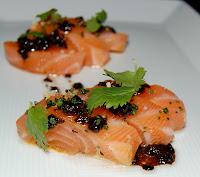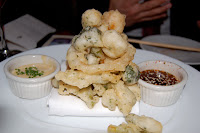

Uni is unique for a few reasons. First, its small subterranean space gives the illusion of being a private dining room, exclusive to the few that can find it. Second, the fish is truly the best that is possible. This means that certain fish are flown in directly from Japan and are rarely seen on sushi menus. Finally, although you can eat the fish plain in the form of sashimi, Chef Chung prefers to layer garnishes and sauces in unexpected ways. While my group debated the extent to which you could still retain and appreciate such glorious pieces of fish, we all agreed that the preparation of each dish was outstanding.
The bartender sent out a Shisho Bourbon Smash as drink. The floral scent of the basil-like shisho leaves combined beautifully with the smooth bourbon and complimented the dishes that followed.
We began with “Anago Tempura.” This consisted of a shirred egg that had been scrambled with butter, yogurt and fleur de sel until it was barely cooked, then placed back into an egg shell. It was comfort food at its best, and I had to restrain myself from not devouring it without sharing it with my companions.


It was served with salt water eel that had been perfectly fried and was then dusted with a light coating of green tea salt. This was the first of many examples of how a simple garnish, the salt, brought out the flavors of the fish.
This was followed by one of the highlights of the night, and one of the signature dishes of the restaurant: a dramatic presentation of Uni. Uni, or sea urchin, had been freshly gathered from Maine. It was served on Tairagai or Japenese pan shell, a chewy fish reminiscent of clams or scallops. It was topped with a salty combination of XO (or dried fish) sauce, myoga (the bud of a ginger plant) and garlic sauce sauce.

I have never quite understood the attention given to Uni, but here, this time, I got it. The XO sauce stood up to the unctuous, smooth and rich taste of the urchin. You could feel a sigh around the table as we stared at the empty shell, hoping, some how that more uni would miraculously appear.

Next, we had “Rock Shrimp Tempura." This salty, sweet, crunchy combination was addictive. The coating was light, but barely covered the shrimp so that the freshness of the seafood still was dominant. We also had one more tempura of Seasonal Vegetables that was brightened by a miso aioli.

A chilled bowl of “Tuna Ceviche” came swimming in a creamy, spicy broth of coconut milk, chilis and lemongrass and topped with fried ginger. I reached for spoonfuls of this broth repeatedly, divinely cloaking morsels of perfect tuna. The sauce would be a perfect foil for most anything-chicken, pork or even shrimp.

However, two of my favorite dishes were still to come. First, was a “Scottish Salmon,” pictured at the top of this post. What arrived were glorious wedges of salmon, coated in a “Chinese black bean tapenade.” At the end of the meal I asked the Chef how he made this delicious salty-sweet topping. He was willing to share that he used Chinese fermented black beans that were mixed with fresh ginger and garlic. I have only had black bean sauce that has been sauteed on high heat. This, preparation was savory and perfect for the richness of the salmon.
Another unforgettable preparation was the Ainame. I had never tried Japanese greenling (or heard of it for that matter!). Flown in from Japan that morning, it was a light white fish.

It was topped with shiso, an Asian pear puree, romesco and benetade (a Japenese microgreen.) Not only was the dish visually stunning but together the fruit and citrus contrasted beautifully.
Our last of Chef Chung’s creations was “Houbou”, another fish that I had never encountered before. Also known as Japanese Sea Robin, this tender fish was topped with candied yuzu kosho (a citrus fruit), radishes and myoga.

As wonderful as these preparations were, Chef Chung kindly sent out a plate of sashimi so that we could taste each fish at its purest level. A study in tones of cream and white, we were treated to tastes of amberjack, sea bream, pan shell, greenling and the huobou.

Tasting each fish, independent of its garnishes, made it possible to appreciate the freshness, the careful carving of the fish and the range of textures that are so easily obscured at other sushi restaurants.
Born in Hawaii, raised in Macao and having cooked throughout the country, Chef Chung clearly enjoys incorporating styles and tastes from many places. If you would like the pleasure of enjoying Chef Chris Chung’s innovative cuisine you have three options. First, if you are so lucky, he can come to your house to prepare a meal. A more affordable option, but one that will require your patience, is to wait until he opens AKA, a new French Bistro/Sushi bar. It will be located in Lincoln and he plans to open it this March with Christian Touche. Or, race out to Uni while he is still the head chef.
Uni Sashimi Bar at the Eliot Hotel, 270 Commonwealth Ave, Boston, 617-536-7200


ok, is this one birthday dinner material?
ReplyDelete